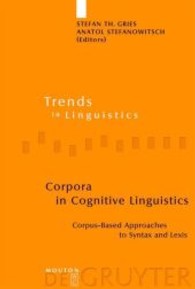- ホーム
- > 洋書
- > ドイツ書
- > Mathematics, Sciences & Technology
- > Technology
- > electronics, electrical engineering, telecommunications
Full Description
This book is intended as a manual on modern advanced statistical methods for signal processing. The objectives of signal processing are the analysis, synthesis, and modification of signals measured from different natural phenomena, including engineering applications as well. Often the measured signals are affected by noise, distortion and incompleteness, and this makes it difficult to extract significant signal information. The main topic of the book is the extraction of significant information from measured data, with the aim of reducing the data size while keeping the basic information/knowledge about the peculiarities and properties of the analyzed system; to this aim, advanced and recently developed methods in signal analysis and treatment are introduced and described in depth. More in details, the book covers the following new advanced topics (and the corresponding algorithms), including detailed descriptions and discussions: the Eigen-Coordinates (ECs) method, The statistics of the fractional moments, The quantitative "universal" label (QUL) and the universal distribution function for the relative fluctuations (UDFRF), the generalized Prony spectrum, the Non-orthogonal Amplitude Frequency Analysis of the Smoothed Signals (NAFASS), the discrete geometrical invariants (DGI) serving as the common platform for quantitative comparison of different random functions. Although advanced topics are discussed in signal analysis, each subject is introduced gradually, with the use of only the necessary mathematics, and avoiding unnecessary abstractions. Each chapter presents testing and verification examples on real data for each proposed method. In comparison with other books, here it is adopted a more practical approach with numerous real case studies.
Contents
In what cases the non-linear fitting problem is reduced to the well-known linear least square method? The Eigen-Coordinates method..- A nontrivial example of the application of the ECs method: Description of the blow-like signals..- The statistics of the fractional moments and its application for quantitative "reading" of real data..- The quantitative "universal" label (QUL) and the universal distribution function for the relative fluctuations (UDFRF). .- Description of the partly correlated random sequences: Replacement of the random sequences by the generalized Prony spectrum..- The general theory of reproducible and quasi-reproducible experiments..- Non-orthogonal Amplitude Frequency Analysis of the Smoothed Signals (NAFASS) and its application for the description of multi-frequency signals..- NIMRAD in action: Application








